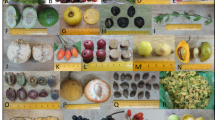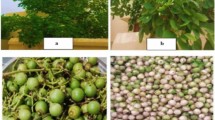Abstract
Phytochemicals including minerals, total phenolics, total flavonoids and antioxidant capacity were measured with ferric reducing antioxidant power and radical scavenging capacity (2,2-diphenyl-1-picrylhydrazyl or DPPH) in fruits of three wild/semi domesticated Momordica species (Momordica dioica, M. subangulata subsp. renigera and M. cochinchinensis) of south east Asia. Momordica dioica had significantly high crude protein (1.86 g/100 g), crude fat (1.0 g/100 g), total sugar (11.36 g/100 g), reducing sugar (9.6 g/100 g) and starch (8.72 g/100 g) in comparison to other species. Among the minerals analysed, phosphorus, iron and copper content was maximum in M. subangulata subsp. renigera (0.37 %, 119.80 ppm, 10.80 ppm respectively) while magnesium and zinc content was maximum in M. dioica (0.18 %, 37.40 ppm respectively). Interestingly, in contrast to all other minerals, manganese content was significantly higher in M. cochinchinensis (178 ppm). The total phenol, total flavonoids, DPPH and FRAP values ranged from 26.08 to 106.89 mg gallic acid equivalent/100 g, 0.99–12.45 mg catechin equivalent/100 g, 43.56–81.73 mg ascorbic acid equivalent/100 g, 5.75–65.84 mg ascorbic acid equivalent anti-oxidant capacity/100 g, respectively. Among the species studied M. dioica showed the highest antioxidant activity as it contains total phenol (106.89 mg/100 g), total flavonoids (12.45 mg/100 g), DPPH (81.73 mg/100 g) and FRAP (65.84 mg/100 g). From the present study, it is concluded that these traditional vegetables may contribute in a significant way to the food and nutritional security and balanced diets of both rural and urban households besides being a potential source of natural antioxidant.

Similar content being viewed by others
References
Padulosi S, Hodgkin T, Williams JT, Haq N (2001) Underutilized crops: trends, challenges and opportunities in the 21st century. IPGRI, Rome, p 222
Ames BN, Shigenaga MK, Hagen TM (1993) Oxidants, antioxidants, and the degenerative diseases of aging. Proc Natl Acad Sci USA 90:7915–7922
Dillard CJ, German JB (2000) Phytochemicals: nutraceuticals and human health. J Sci Food Agric 80:1744–1756
Prior RL, Cao G (2000) Antioxidant phytochemicals in fruits and vegetables: diet and health implications. HortSci 35:588–592
American Association of Cereal Chemists (2001) The definition of dietary fiber. Cereal Foods World 46:112–126
Weisburger JH, Reddy BS, Rose DP, Cohen LA, Kendall ME, Wynder EL (1993) Protective mechanisms of dietary fibers in nutritional carcinogenesis. Basic Life Sci 61:45–63
Beltran-Orozco MC, Oliva-Coba TG, Gallardo-Velazquez T, Osorio-Revilla G (2009) Ascorbic acid, phenolic content and antioxidant capacity of red, cherry, yellow and white types of pitaya cactus fruit (Stenocereus stellatus Riccobono). Agrociencia 43:153–162
Keen CL, Holt RR, Oteiza PI, Fraga CG, Schmitz HH (2005) Cocoa antioxidants and cardiovascular health. Am J Clin Nutr 81(Suppl):298S–303S
Vita JA (2005) Polyphenol and cardiovascular disease: effects of endothelial and platelet function. Am J Clin Nutr 81(Suppl):292S–297S
Aoki H, Kieu NTM, Kuze N, Tomisaka K, Chuyen VN (2002) Carotenoid pigments in gac fruit (Momordica cochinchinensis Spreng). Biosci Biotechnol Biochem 66:2479–2484
Ishida BK, Turner C, Chapman MH, McKeon T (2004) Fatty acid and carotenoid composition of gac (Momordica cochinchinensis Spreng) fruit. J Agric Food Chem 52:274–279
Voung LT, Franke AA, Custer LJ, Murphy SP (2006) Momordica cochinchinensis Spreng. (gac) fruit carotenoids reevaluated. J Food Compos Anal 19:664–668
Kubola J, Siriamornpun S (2011) Phytochemicals and antioxidant activity of different fruit fractions (peel, pulp, aril and seed) of Thai gac (Momordica cochinchinensis Spreng). Food Chem 127:1138–1145
John JK, Bharathi LK (2008) Sweet gourd (Momordica cochinchinensis (Lour) Spreng). In: Peter KV (ed) Underutilized and underexploited Horticultural Crops, vol 4. New India Publishing Agency, New Delhi, pp 185–191
Ali M, Shrivastava V (1998) Characterization of phytoconstituents of the fruits of Momordica dioica. J Pharmacet Sci 60:287–289
Behera TK, John JK, Bharathi LK, Karuppaiyan R (2011) Momordica. In: Kole C (ed) Wild crop relatives: genomic and breeding resources. Springer, Berlin, pp 217–246 ISBN 978-3-642-20449-4
Semiz A, Sen A (2007) Antioxidant and chemoprotective properties of Momordica charantia L. (bitter melon) fruit extract. Afr J Biotechnol 6(3):273–277
Kubola J, Siriamornpun S (2008) Phenolic contents and antioxidant activities of bitter gourd leaf, stem and fruit fraction extracts invitro. Food Chem 110(4):881–890
Wu SJ, Ng LT (2008) Antioxidant and free radical scavenging activities of wild bitter melon (Momordica charantia Linn. var. abbreviata Ser.) in Taiwan. LWT 41:323–330
Sumanth M, Nagarjuna GC (2010) Antimutagenic activity of aqueous extract of Momordica charantia. Int J Biotechnol Mol Biol Res 1:42–46
Islam S, Jalaluddin M, Hettiarachchy NS (2011) Bio-active compounds of bitter melon genotypes (Momordica charantia L.) in relation to their physiological functions. J Funct Foods Health Dis 1(2):61–74
Benitez MM, De Guzman CC (2012) Antioxidant content of bitter gourd (Momordica charantia L.) grown in different nutrient amendments. In: UMT 11th international annual symposium on sustainability science and management, 9–11 July 2012, Terengganu, Malaysia, pp 136–143
AOAC (2005) Official methods of analysis of the association of official analytical chemistry, 18th edn. Association of Official Analytical Chemists, Washington, DC
Ranganna S (2001) Proximate constituents. In: Ranganna S (ed) Handbook of analysis and quality control for fruit and vegetable products. Tata McGraw-Hill, New Delhi, pp 12–17
Kim DO, Chun OK, Kim YJ, Moon HY, Lee CY (2003) Quantification of polyphenolics and their antioxidant capacity in fresh plums. J Agric Food Chem 51:6509–6515
Brand-Williams W, Cuvelier ME, Berset C (1995) Use of a free radical method to evaluate antioxidant activity. Lebensmittel Wiss Technol 28:25–30
Benzie IF, Strain JJ (1996) The ferric reducing ability of plasma (FRAP) as a measure of ‘antioxidant power’: the FRAP assay. Anal Biochem 239:70–76
Gopalan C, Ram Sastri BV, Balasubramanian SC (1982) Nutritive values of Indian foods. National Institute of Nutrition (ICMR), Hyderabad, AP, India
Parvathi S, Kumar VJF (2002) Stdies on chemical composition and utilization of the wild vegetable athalakkai (Momordica tuberosa). Plant Foods Hum Nutr 57:215–222
Ullah M, Chy FK, Sarkar SK, Islam MK, Absar N (2011) Nutritional and phytochemical analysis of four varieties of bitter gourd (Momordica charantia) grown in Chittagong Hill tracts. Asian J Agric Res 5:186–193
AVRDC (2002) Progress report. Asian Vegetable Research and Development Center, Shanhua, Tainan, Taiwan, p 122
Ali A, Deokule SS (2009) Studies on nutritional values of some wild edible plants from Iran and India. Pak J Nutr 8(1):26–31
Ali A (2010) A comparative study of nutrients and mineral molar ratios of some plant foods with recommended dietary allowances. Adv J Food Sci Technol 2(2):104–108
Ali A, Deokule SS (2010) Elements evaluation of some edible vegetables and fruits of Iran and India. Asian J Agric Sci 2(1):35–37
Ali A (2011) Determination and comparison of potential nutritive values and mineral elements of three important food edible plants from southern part of Iran. Croat J Food Technol Biotechnol 6(3–4):148–151
Huang Y, Tan A, Shen Y, Lu J (1998) Scavenging effect of total flavonoids of Lycium barbarum L. On active oxygen radicals and inhibitory effects on heat output from L 1210 cells. Wei Sheng Yen Chiu 27:109–111
Kaur C, Kapoor HC (2002) Antioxidant activity and total phenolic content of some Asian vegetables. Int J Food Sci Technol 37:153–161
Ali A, Deokule SS (2008) Comparison of phenolic compounds of some edible plants of Iran and India. Pak J Nutr 7(4):582–585
Ali A, Deokule SS (2010) Comparative study on polyphenol content in some food plants. Asian J Food Agro India 3(2):212–216
Islam MS, Yoshimoto M, Ishigure K, Okuno S, Yamakawa O (2003) Effect of artificial shading and temperature on radical scavenging activity and polyphenolic composition in sweet potato (Ipomea batatas L.) leaves. J Am Soc Hortic Sci 128:182–187
Sunita S, Kapoor IPS, Singh G, Schuff C, Lampasona MP, Catalan CAN (2013) Chemistry, antioxidant and antimicrobial potentials of white pepper (Piper nigrum L.) essential oil and oleoresins). Proc Natl Acad Sci India Sect B Biol Sci doi:10.1007/s40011-012-0148-4
Mani D, Kumar C, Srivastava RK (2007) Effect of calcium, zinc and organic matter on the uptake of cadmium in Brassica rapa L. (turnip). Proc Natl Acad Sci India 77(2):263–276
Author information
Authors and Affiliations
Corresponding author
Rights and permissions
About this article
Cite this article
Bharathi, L.K., Singh, H.S., Shivashankar, S. et al. Assay of Nutritional Composition and Antioxidant Activity of Three Dioecious Momordica Species of South East Asia. Proc. Natl. Acad. Sci., India, Sect. B Biol. Sci. 84, 31–36 (2014). https://doi.org/10.1007/s40011-013-0205-7
Received:
Revised:
Accepted:
Published:
Issue Date:
DOI: https://doi.org/10.1007/s40011-013-0205-7




